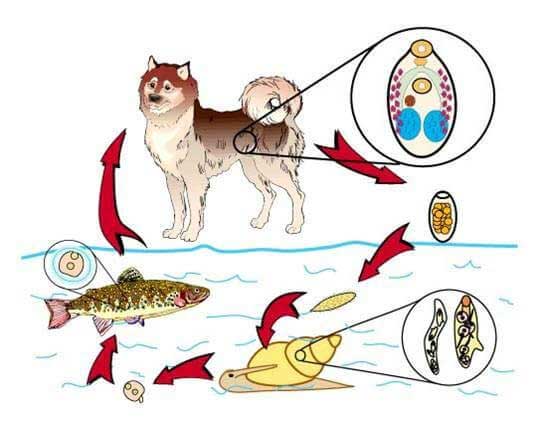Something’s fishy. Is it Salmon poisoning?

Kicking off 2020, we decided to discuss a topic regarding a case we recently had in which a dog was diagnosed with salmon poisoning.
What is salmon poisoning?
Salmon poisoning is caused by a rickettsial bacterial called neorickettsia helminthoeca. It’s found exclusively in the Pacific Northwest as it requires several intermediate hosts.
If anyone is familiar with tick-borne diseases such as Rocky Mountain Spotted Fever or Ehrlichia, this is in the same family of organisms. Instead of a tick bite, this organism is transmitted by ingesting raw or partially cooked salmon (and some other types of salmonid fish).
Where does it come from?
This is where things get complicated (or very interesting depending on your level of nerdiness).

The life cycle starts with the eggs of the rickettsial organism being excreted in the stool of infected dogs (or other wild canids). Once the eggs hatch, the emerging organism infects snails whose habitat is in or around areas of brackish stream water. The organism goes through another change in the snail and is released into the water as freely-swimming larvae. The swimming larvae then penetrate the skin of salmonid fish and live within the fish (the liver, skin, and sometimes in the slime around the fish).
The dog is the final step in the life cycle. Once a dog ingests the infected fish, the organism (neorickettsia salmincola) sets up shop in the intestines. After an initial incubation period of about one week, the organism (now neorickettsia helminthoeca) enters the bloodstream through the inflamed/damaged intestinal walls. Once in the bloodstream, the infection can spread anywhere in the body.
What does a salmon poisoning infection look like?
The most common presentation is loss of appetite and a fever. There can be a range of other clinical signs including vomiting, diarrhea, weight loss, weakness, enlarged lymph nodes, abdominal pain, or neurologic signs.
Diagnosis can be made via fecal examination of the eggs. The organism can also be isolated from the peripheral lymph nodes (if they’re enlarged). If none are found, then sometimes a presumptive diagnosis is made after excluding other diseases that can present in a similar way. A history of eating raw salmon is a very important piece of information that can clue us in on this disease being a possibility.
How is it treated?
The most important treatment is with an antibiotic to get rid of the bacteria as well as a deworming medication to clear the organism from the intestines. Often, hospitalization and supportive care are needed after the diagnosis (or presumptive diagnosis) is made.
How can we prevent this?
The only way to avoid this disease is to prevent your dog from eating raw salmon (or some other types of raw/undercooked fish).
